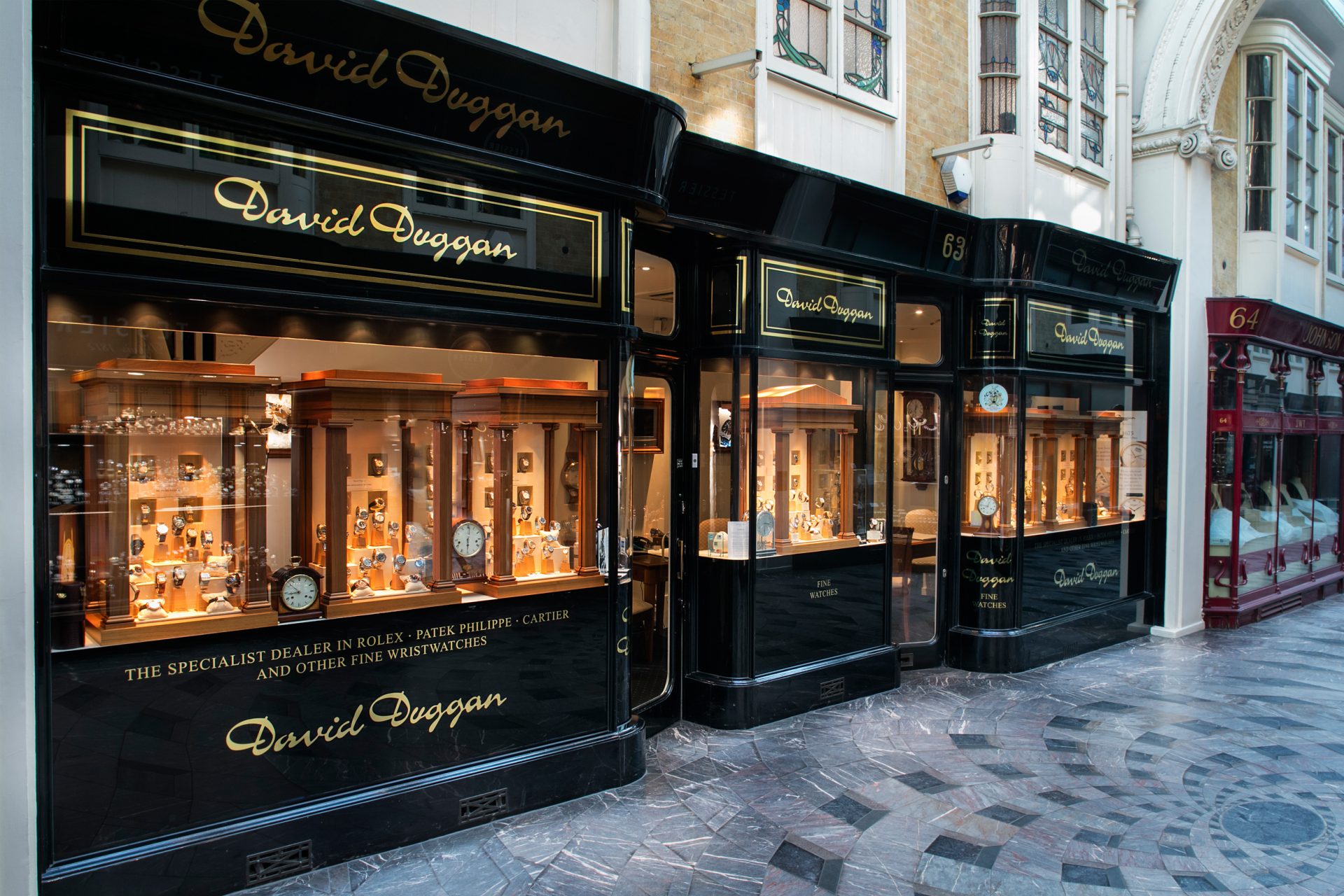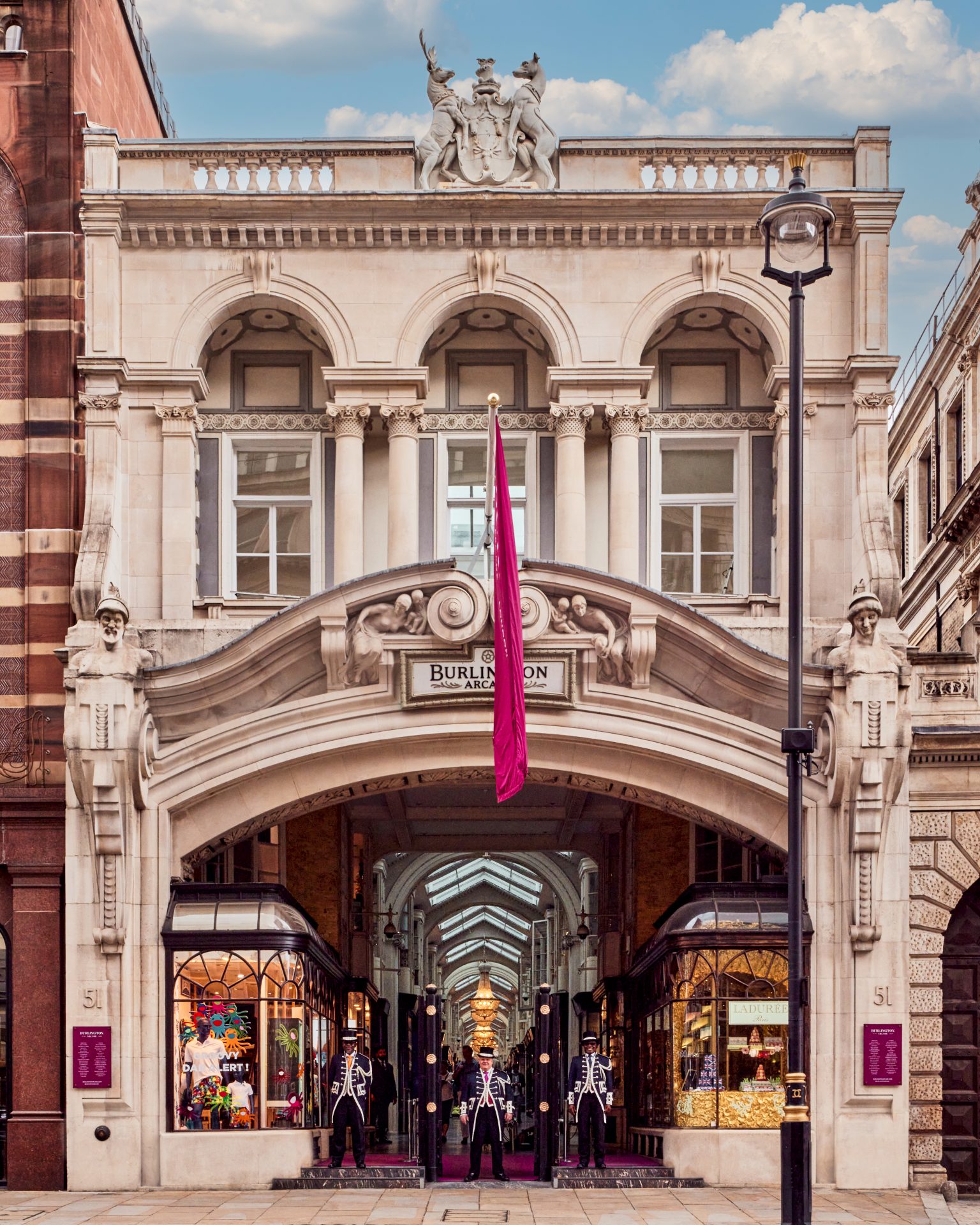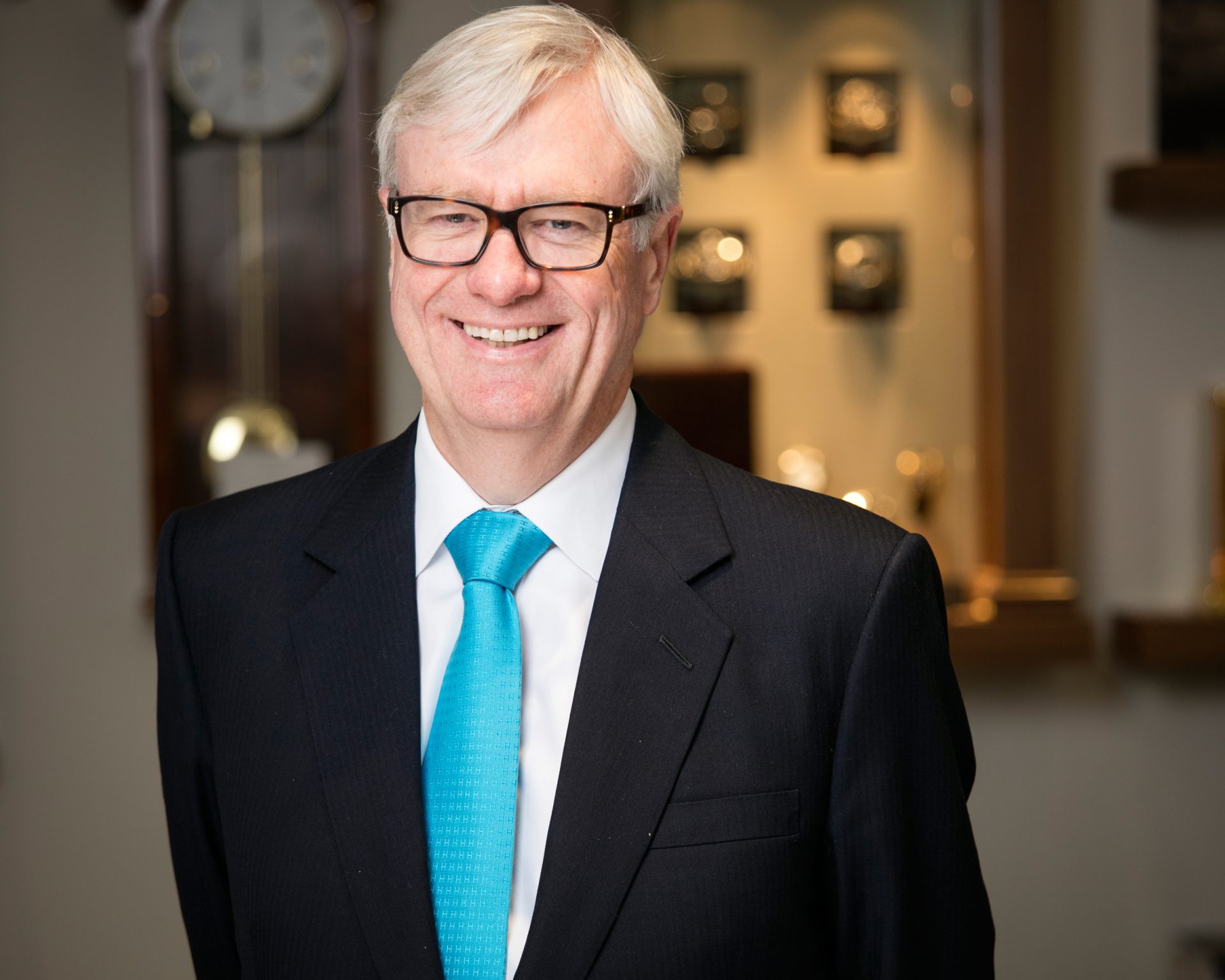Based at his Burlington Arcade boutique since 2002, David Duggan is one of the world’s most trusted names in vintage watch dealing. He talks to Tracey Llewellyn about the boom in collecting, his most memorable moments and the ones that got away.
WatchPro: How did you become a watch dealer?
David Duggan: My brother John was a coin dealer in Lancashire and from 1976 on I would spend every weekend working with him, travelling to different towns around the UK. John was a pioneer – he would advertise that we were going to be in a certain area in the best local newspaper from Monday to Thursday. We would then set up camp in the best hotel on Friday and Saturday and people would bring in coins, gold chains, pocket watches – we’d be mobbed.
I did that for seven years, and it gave me great experience, dealing with the public. But John was not as big a fan of pocket watches as I was, so I decided to go out on my own in 1983. After a month, I realised there wasn’t a market for pocket watches but I did see that the demand for wristwatches was coming through – even then. I remember being with a jeweller friend and he bought a manky-looking, steel watch for £100. Afterwards I said ‘What have you bought that for? Look at it’. And he said, ‘Because it’s a Rolex. Even in this condition, I will double my money.’ So, from there onwards, I started visiting all around the markets – Charnock Richard, Bradford, Stafford, Newmarket, Bermondsey, Camden Town and, of course, Portobello Road.
I went all over the country chasing watches and would scour stalls that were mainly selling jewellery. I was always after little Rolex Princes, because any piece in a decent condition would fetch easily £1,200. If you could buy a few of those, it was good week’s work. Then a dear old Italian friend advised me to stop chasing Rolex and to get into Patek Philippe. And that’s what I did in around 1986.
At that time, Daytonas were dirt cheap because nobody wanted them. I remember going to the Birmingham Bullring, where there was a fair once a month. One dealer was always there and he had three watches priced at £350 stuck in the corner of his cabinet and they never moved. The trio consisted of two Paul Newman Daytonas and a Milgauss black dial ref. 1019. Nobody wanted them. Nobody. Everyone wanted steel and gold Datejusts – well, it was the 1980s, they were cool.

WP: So how did you go from trawling the markets to life in Burlington Arcade?
DD: Back then, I was selling mostly into the jewellery trade. I knew probably three good jewellers that always wanted to buy from me. I used to have a sports bag packed with a box of diamond rings, a few watches and £5,000 in cash. An old friend told me that I should always have a squash racquet sticking out of the bag, so I did. I think that racquet must have saved my bacon many a time – and I have still never played a game of squash in my life.
I was in London every Tuesday, Thursday and Saturday and I was building my contacts there and that’s how I was offered a slot in the Antique Centre on Bond Street – I snapped it up, even though it was the one nobody wanted, downstairs by the toilet and furthest from the action. And that’s where I started in 1989, with my late-partner Denise – to be honest, without her I would still be running around with that little sports bag.
Within three years we took a gamble and moved to the front shop and we stayed there for more than 17 years. The landlord became a client and a good friend. One day close to the time the lease was coming up for renewal, he took me to one side and told me that the rents would be increasing from £98,000 to £250,000. He advised me to look for something else.
I miss the Antique Centre, but Burlington Arcade is a bit more glamorous and definitely more secure. We had an open unit before, the first one after the entrance door, and although we never experienced a snatch, it was always a possibility. And at least I’ve got a business to sell when I retire – although I don’t think that will ever happen.
WP: How did you source the watches?
DD: I learnt from the coin business that if you advertised big, you got plenty of stuff. For 27 consecutive years, we ran an advert in the Sunday Times in the car section. Watches and cars have always gone hand-in-hand and I knew that every Sunday blokes were looking at the motoring classifieds and dreaming, so for us to say ‘we will buy your watch’ was perfect placement.
I used to go in all the car magazines – I had an ad in Exchange & Mart every fortnight for 22 years – and took a front-page slot with the Daily Telegraph. We ran in the Daily Mail and in BA’s High Life magazine next to the map section. We were spending about £140,000 a year back in the 1990s. Print advertising made a huge difference to our business.
Business was a great deal of fun then, because you had a go at everything – Chopard, Longines, Omega, IWC, Jaeger-LeCoultre. Today it is nowhere near as exciting in comparison because we are mainly dealing with Rolex and Patek Philippe, plus a few pieces from Cartier, Vacheron Constantin, Breguet, F.P. Journe and Richard Mille.
Eventually the Sunday Times wanted to move me into the glossy magazine section which wasn’t quite the same. And then around 2005, the internet boom happened and I realised that, beyond print, we had to get a good website.
WP: By this time, was watch collecting was a big thing?
DD: No, not yet. In the 1990s old Patek Philippe world timers that sell for £2m now could be picked up for £60,000. A Nautilus would be about £1,250.
But I clearly remember that early in that decade, the Italian dealers started coming over to London. In those days, the dealers were all men and their wives were wearing steel and gold Submariners. This was 1990/91. The Chelsea girls didn’t start doing that until around 2015. I’m telling you, the Italians were a good 25 years ahead of us. That’s why I love them. Those Italian boys and girls have real style. They used to come over and come to me on Friday afternoon, and then go to Portobello Road on Saturday – back then you could still pick up Pateks on Portobello.
In 1989, there were only about four of us that were full-on, VAT-registered watch dealers in the UK. And then of course, through the 1990s, word started spreading. People would come to our little unit on Bond Street, see how busy we were and think, ‘this is the game to be in, not jewellery’. But we had a great run in the 1990s and right through to 2007.
WP: What have been the biggest changes in dealing?
DD: I think the first change came with the advent of the internet – about 1998 – and it just seemed to explode. Osvaldo Patrizzi was the first guy to take advantage of the new interest. Before him an auction catalogue held just the basic information but he changed all that, beefing it out and adding glamour. And then Aurel Bacs came along in the early 2000s, making watch selling a spectacle. What a showman.
So, the internet caused a small explosion, but the big bang really came with covid. Suddenly a lot of people were given a lot of money by the government. There was nowhere to go to spend it and the banks were not paying any interest so, for some, the gambler’s instinct kicked in. People who had never been interested in watches before treated themselves to one then quickly sold at a profit and kept going like that.
WP: And that brought a new way of selling, too?
DD: I’ve been in the game for 47 years and of all the dealers I’ve met, there aren’t many that I fully trust. People often come to us and say ‘this is a very old-fashioned set-up but we feel comfortable’. Old fashioned values are few and far between – simple things like honouring offers that you make and paying immediately and on the spot. I was told back in the 1980s to get people into the shop with an offer but to always give less money when you have the watch. I used to travel from the north of England to London and when this happened to me it was painful.
I think there is sometimes a lack of respect and a kind of arrogance. I like humility and I appreciate people who have learnt their trade, paid their dues and deal in a very straightforward manner.
WP: What are some of the most memorable pieces you have had through your hands?
DD: There have been so many great pieces like the Patek Philippe-Asprey chronograph ref. 2499 first series. I paid £55,000 for it. A good friend saw it and wanted it but I told him that I already had a client that I thought would go to £75,000. He looked at it and put it in his pocket. I said ‘what are you doing?’ and he said ‘I’ve bought it. I’ll give you £75,000’. I only had the watch for 10 hours and, for the next 10 years, I tried to buy it back. Ten years later he came to me and said, ‘I’ve got to put the kids through university, so let’s have a deal’ and I bought it back.
This was 2006. Alex Barter at Sotheby’s London looked at it and found that it had ‘Asprey’ engraved inside the case as well as on the dial, which is rare and he persuaded me to put it in the next big watch auction. On the day of the sale, I got a call at 4pm from Alex. His voice was trembling and he said, ‘Mr Duggan, you’ve just broken the world record at Sotheby’s for the sale of a wristwatch: CHF2m’. That was the only result I have ever had at auction. [The watch sold again at Sotheby’s in 2018 for CHF4m.]
On another occasion in the 1990s, a man came into the shop and asked if I was interested in buying a ‘brand-new’ Rolex Prince. I told him that they were all made in the 1930s and there is no such thing as a new version. He reached into an old doctor’s bag that he was carrying and it was like opening the door to the tomb of Tutankhamun.
The first thing he pulled out, I nearly said, ‘that’s a fake’ because the box was brand new. I opened it and there was a brand-new guarantee and a brand-new Prince with a brand-new spare strap. I looked at him and he said, ‘would you like to see another one?’ I opened the box he handed to me and there was a brand-new silver Prince. He said, ‘do you want to see another?’ This time an 18-carat, straight-sided model. So, I bought all three and, as he left, he told me he would be back in a few weeks. When he came back, I bought another three, including a striped 18-carat piece that you could shave on. It’s original price of 19 guineas was still on the box. I really wish I’d kept it.
It turns out the client’s grandfather had owned a jewellery shop in the 1930s and when anything really good came in, he would put it to one side and say, ‘that will be for my grandsons’ inheritance. He brought all sorts of stuff in – Georgian silver tankards, stamp collections, banknote collections. Wonderful. I went on a lovely adventure with him. We still exchange Christmas cards.
WP: And what’s ‘the one that got away’?
DD: Stella dials were one of my early discoveries. I was buying the blue, mint and pink versions that nobody wanted. If dealers had them, they were getting them painted champagne so they could sell to the Chinese market. It was wonderful. You know, when you’re buying something that nobody wants, you can get it at the right price. I had a contact that was buying them from me but when I lost him, I started repainting the ones I had too.
There is one that really stings though. A friend and client came into the shop one day in 1992 with a steel Patek Phillippe ref. 1518 perpetual calendar chronograph. I trusted the man who brought it in and always bought from him. It looked absolutely right, but I knew that 1518s were only ever made in gold. He wanted £22,000 for it and that was a lot of money then so I hesitated.
I thought about it for an hour and rang another friend of mine for advice. He told me that, in fact, Patek had made four examples in steel. I immediately rang my client, but he had literally just sold the piece to a local dealer. Today that piece would fetch $10-11m.
WP: You’ve had a lot of high-profile clients over the years?
DD: Many politicians, sportsmen, musicians and actors, but we never talk about any of our living clients. One that I remember well and very fondly, however, is Cilla Black. She loved Cartier watches and always came to see me at the end of the day after a champagne lunch and say, ‘Hello, Chuck. Have you anything to show me today?’ She was great fun. Happy days.
WP: Away from vintage, you are an authorised Tudor dealer?
DD: Yes, we are the only pre-owned store to have AD status in the UK. When I saw the Black Bays in Basel in 2012, I thought they were vintage. I offered right there and then to become a dealer. In 2016, I was invited to a Rolex event and I met the new UK Tudor brand manager. I told him the story and it appealed to him and within six months we had a dealership.
I really believe they are the best value watch on the market. The Black Bay has made Tudor very cool – and getting David Beckham as an ambassador was a real coup.
WP: Do you have any tips for buying vintage today?
DD: One good tip, is to buy what nobody wants at the moment. I love rectangular Pateks but right now they are not that popular. I think there is a lot of mileage still in vintage time-only Vacherons and Audemars Piguets from the 1950s and 1960s. And I’ve always been a fan of vintage Longines chronographs, but people are cottoning on now.
I also love an alarm watch – particularly the Vulcan Cricket. With many modern alarm complications, you need the ears of an owl to hear them, whereas a Cricket will have you up and out of bed in a flash.
WP: Do you think the vintage marketplace is cooling?
DD: It definitely is, for a number of reasons – the war in Ukraine, the labour shortage caused by Brexit that is pushing up pay, and the ups and downs of Bitcoin are all playing their part. But it is still an incredibly strong market and I will buy second-hand Patek Philippes and Rolexes all day long. I would rather have my money in a good second-hand Patek with box and papers than have it in the bank.



A visit to David Duggan’s store was one of the least pleasant retail experiences I’ve ever had. I had money to spend and was eager to purchase a Rolex Explorer. However, a sales assistant at Duggan’s, a bald man in his 50s, tried to sell me a watch with a clearly and deeply chipped crystal. Since entering the shop, he had been fairly rude. When I pointed out the damage and suggested I wasn’t interested in a clearly damaged watch, and that I’d consider another watch they had in stock, his manner became high-handed and insulting. Needless to say, I didn’t make a purchase.
Thank you for your comment Chad,
We are truly sorry to hear about your negative experience at the shop. As a team we always make sure that we offer outstanding customer service and we treat all our client with respect. If you had a bad experience on this particular day , we can only apologise and make sure we deal with it so there will be no repeats. We would be more than happy to welcome you back in the shop to discuss if you would wish to consider us again.
Wishing you all the best,
David Duggan and team
I once entered the David Duggan store and mentioned I had an unworn Daytona I was looking to sell.
I was given a price and agreed to bring the watch in to do a deal.
The following week I took the Daytona in and David Duggan gave me a derisory low ball offer instead of the price already agreed. Whether he thought I’d just accept the low ball because I’d made the effort to take the watch in I have no idea, but I simply left without a deal.
I found the whole experience throughly unpleasant and I would not set foot back in that store if you paid me. I expect people to do business in a decent and ethical manner.